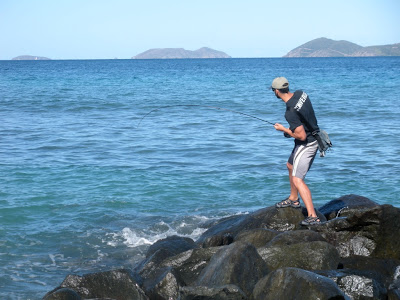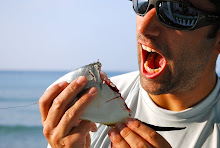
Flash-forward to Saturday morning. After consulting the lunar cycles and cross-referencing them with the tide charts we realized that early on Saturday morning would be a rising tide with an almost-full moon. In other words, seemingly perfect conditions. We hit the beach at 7:00am and started blind-casting off of the two parallel jetties.


View from the other jetty.
I was attempting to cast to the left side of my body by false casting to the right and laying a cast behind me on the backhand when, as soon as my fly hit the water and in the exact same spot, a sea turtle surfaced for a breath. As he sunk beneath the surface and moved away, my line went with it. I had accidently snagged a sea turtle.
I quickly loosed the drag as far as it would and let the turtle go. I had no idea what to do. Depending on how snagged he was, I thought of my 80lb test line and contemplated just hauling him in, hand-over-hand, as quick as possible to minimize exhaustion, taking out the hook and sending him on his way. Thankfully, after about two minutes of struggling, the hook dropped out and he swam away unharmed but a little frightened.
Sea turtles are everywhere down here. In British Virgin Island Waters there is actually an open-season on all species of sea turtle. Even loggerheads, the largest and one of the most critically endangered of the sea turtles. People on these islands are allowed to hunt and eat them for food, while a mile away, in US Virgin Island waters, having a dead loggerhead, hawksbill or green sea turtle in your possession is punishable by years in jail and tens if not hundreds of thousands of dollars in fines. The BVI is still in the stone-age when it comes to things like conservation, etc. Felt Soul Media guys Ben Knight and Travis Rummell made a video about BVI Waters called 'Preserving Nature's Secrets.' It highlights the struggle for conservation against development in these waters.
Getting back to the fishing, Zach and I had just switched spots when I saw a large fish cruising directly towards me. I laid a contraption I had tied two days earlier made from a short white bunny strip and some turquoise and white bucktail about 5ft in front of the fish. In an instant, it accelerated and took the fly.
With faith in my new heavier line, I offered a hard strip-set and then fed the line through my fingers as the huge fish leapt and thrashed, leapt and cartwheeled towards deeper water.
I've noticed that there are only three things that happen when you hook up with a tarpon:
You strip set before the fish has turned and pull the fly out of it's hinged mouth.
You set correctly but the fury of the hooked fish results in a line quickly cinched around your leg, reel seat, arm, neck, etc and your knots explode from the pressure.
It all comes together and you miraculously get the fish on the reel. However, all this means is that you're now strapped to a giant, pissed-off fish that can shake your hook at any moment, swimming in an ocean of even more giant, hungry fish.
After 10 minutes of pumping and reeling, I had made my way over the slippery rocks to the sandy beach and had the leader in the guides of my rod. As soon as the fish saw us, however, he bolted. Reaching my backing in about one second and showing no signs of slowing down, I scrambled back to the end of the jetty and tightened the drag to the max.
The fish was a hundred yards away and I was standing on a tiny rock at the tip of the jetty when, coming in my direction from the left was an instantly recognizable tan shape, cruising with a definite purpose. A Caribbean Reef shark, 7ft long, rounded the jetty in 4ft of water, turned abruptly, and headed straight for my fish.
Back in the states, some of the most memorable moments for a fisherman might include a pike grabbing onto a bluegill you're reeling in, or a bull trout running down a cutthroat you're trying to bring to hand. The act of predation seared into your memory, never to be forgotten. As the shark approached the tarpon struggling at the end of my line I could do nothing but yelp back to Zach that there was a “huge fucking shark!”
The tarpon had crossed a shallow reef that the shark could not seem to cross. As the tarpon grew tired I realized that I would have to bring it back across the reef and to the shore as quickly as possible to avoid the lurking shark. It's incredible how a shark that size can become invisible in such shallow water.
I hauled the tarpon across the reef and into the channel between the reef and the beach. The shark appeared from nowhere and zoomed straight at the tarpon. They thrashed about in the surf for a few moments as I realized I would probably just be landing a severed head. Then, for reasons unknown, the shark seemed to just be keeping pace with the tarpon instead of eating it. As I brought the fish closer to shore, the shark swam off towards the west. Zach kept an eye out for it as I stepped into the boiling surf to attempt to land the tarpon.

As I used a wave to beach the massive fish, I passed my rod to Zach and lipped the tarpon. We realized right away that it might have been a bit too large for the shark to handle. It was probably twice as heavy as my first tarpon from two weeks ago. I struggled to hoist it for a few pictures, dunked my arm up to the elbow into it's gullet to remove the fly, revived it for a few moments in the surf, and sent it on it's way.
A really thick fish.

Struggling to hoist it.

Facilitating the release through the boiling surf.
Next time, it's Zach's turn.







I caught three creek chubs yesterday...
ReplyDeleteFucking awesome!
ReplyDelete